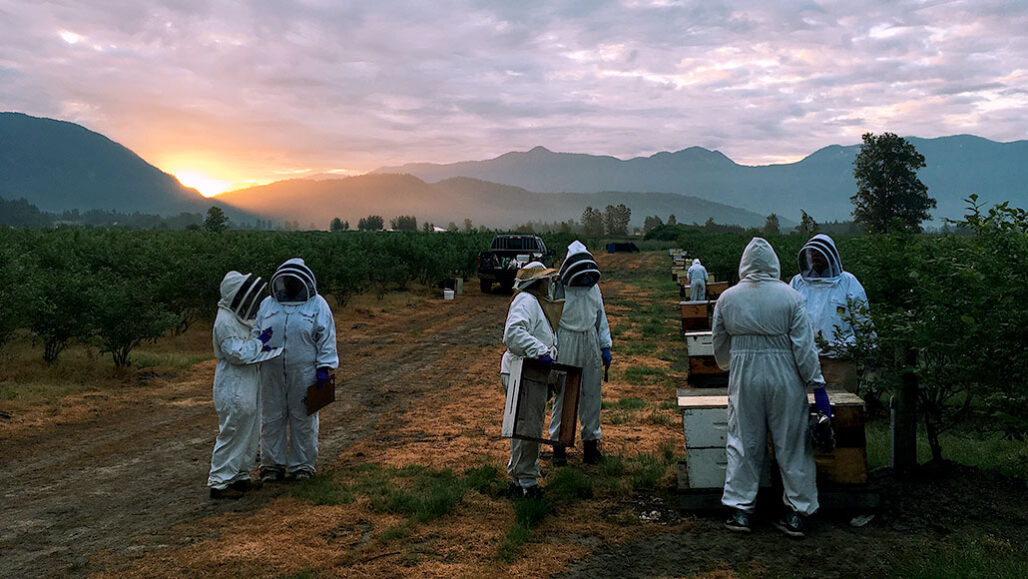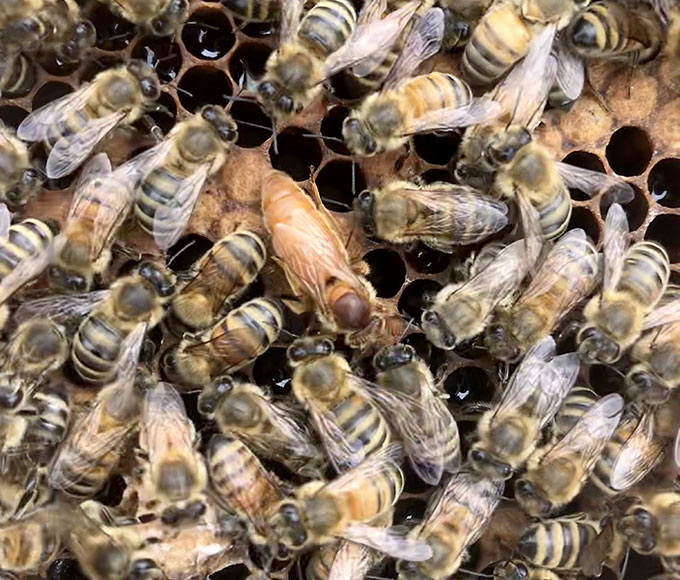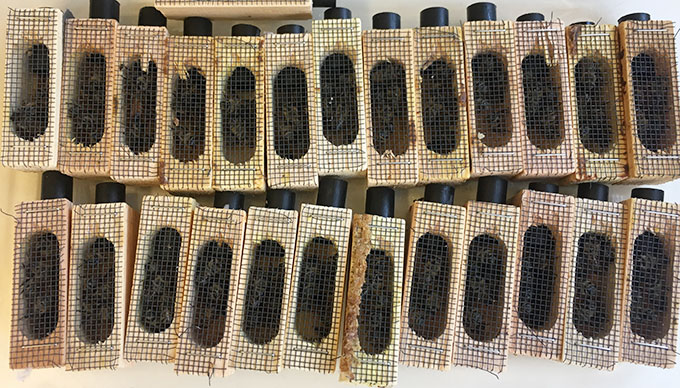Learning what stresses queen bees could save their hives
Keeping queens stress-free ups her hive’s birth rate, ensuring needed pollinators

Researchers from the University of British Columbia collect bees from an apiary to study how healthy they are. Apiaries are collections of human-made beehives. Part of a farm, bees from this particular apiary pollinate local blueberry plants.
Abigail Chapman
When honeybee hives die, the most common cause is something called queen bee failure. That’s when queens produce too few babies to keep the hive going. Finding out why this has happened is not often easy. That has made it hard for beekeepers to prevent. But a new test may change things.
Researchers have found high levels of certain proteins in stressed queens. Which proteins were high varied with the type of stress.
Previous research showed temperature extremes or pesticides can kill sperm cells inside a queen bee. She needs live sperm — male reproductive cells — to fertilize her eggs and produce baby bees. With too few live sperm, her hive will die.
Alison McAfee, who works at the University of British Columbia in Vancouver, Canada, led the new study. Her work focuses on honeybee reproduction. How many live sperm queen bees carry “is important,” she notes. “Honeybees don’t just produce honey,” she points out. “They also pollinate crops.”
Bees gather pollen and nectar from flowers to feed themselves. Along the way, they move pollen between flowers. This pollination fertilizes the female part of a flower. Without that pollination, many plants won’t produce fruit. And that’s a big deal. About one-third of all of the food we eat comes from plants pollinated by bees.

Educators and Parents, Sign Up for The Cheat Sheet
Weekly updates to help you use Science News Explores in the learning environment
Thank you for signing up!
There was a problem signing you up.
How to stress a queen bee
McAfee and her team found that levels of some proteins rose in queens who had gotten too hot. These proteins were even more common when air had been especially humid. The researchers saw a boost in other proteins when a queen had gotten extremely cold or was exposed to low doses of pesticides.
To test all this, the team brought queen bees to its lab and then exposed them to each of these conditions.
Bees are most comfortable at temperatures ranging from 15° to 38° Celsius (59° to 100° Fahrenheit). For tests on heat tolerance, the researchers cranked up the temperature for two hours to 40 °C (104 °F). For the cold test, they turned the thermostat down to 4 °C (39 °F) for two hours. For pesticides, the team applied low doses of common pesticides to the queens’ backs and waited two hours.

After each exposure, the researchers collected fluid from a sac in the queen’s body. This is where she stores sperm. The sac’s fluid protects the sperm. Those sperm cells came from male drone bees the queen had mated with when she was about two weeks old.
A mass spectrometer (Spek-TROM-eh-tur) is an instrument that can analyze the chemicals in a sample. The researchers used such a device to test fluid from the sacs. Queens exposed to extreme heat had very high levels of two particular proteins. Those exposed to extreme cold had high amounts of two different proteins. And those exposed to low-dose pesticides had high levels of yet another set of two proteins.
McAfee and her team didn’t study what any of these proteins do. Their research was designed just to measure what conditions caused protein levels to change.
Hot surprise
Next, the researchers looked for these proteins in failed queens from bee colonies across British Columbia. Compared to healthy queens, most of these bees had high levels of proteins linked to heat or pesticide exposures. Only a few queens had proteins signaling cold.
“I was surprised by the heat proteins,” says McAfee. “We don’t have crazy hot weather here most of the time.”
Maybe, she says, the metal lids some beekeepers put on their hives get hot in the sun, overheating their bees. Or maybe it has to do with how queen bees are shipped across long distances, says Marla Spivak. She is a bee expert at the University of Minnesota in Minneapolis.
“Beekeepers ship queens in the mail across the country to sell to other beekeepers,” she explains. “The queens in their little bee-safe containers may get too hot or cold in the airplane and delivery trucks.”

McAfee agrees this could be a problem. But she would have expected to see more proteins related to cold temperatures in failed queens. That’s because shipping exposes queens to both hot and cold temps. Or, she says, other stressors — such as injury, predators or disease — might turn on production of the same proteins.
Beekeepers usually throw away a failed queen and get a replacement. In the future, says McAfee, “they could ship her to a lab, which would measure the proteins.” Then they might be able to diagnose the likelihood of what had stressed her.
Heat proteins in bees also could be an early warning system for high-temperature stress in other creatures, she says. That’s a concern because climate change is leading to increased heat around the world.
“Heat kills sperm and not just in bees,” says McAfee, but also in other insects and even mammals. “I’m not so worried about humans though. We find other ways to regulate our environment and stay cool.” McAfee and her team described their findings August 20 in BMC Genomics.







